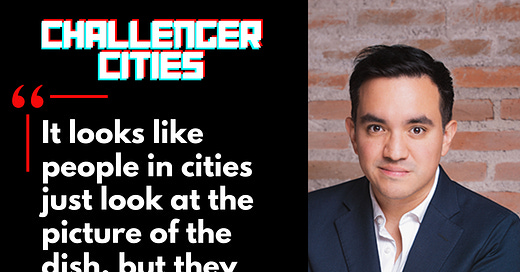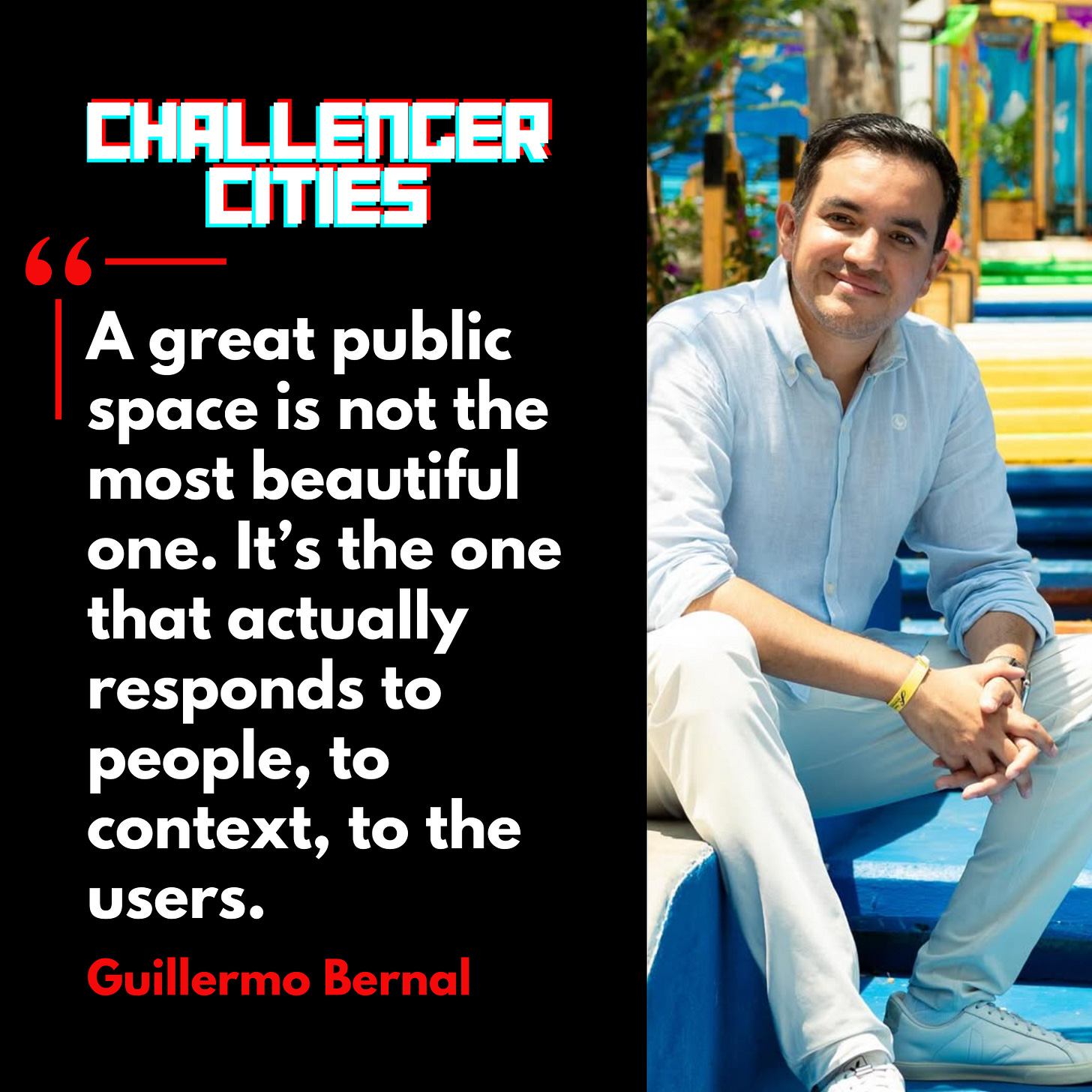Cities don’t work because of glossy plans or polished renderings, as much as the architects and incumbent politicians would like you to believe. They work (and have worked for a long time) because people use them, reshape them and often subvert them in ways no planner predicted.
That’s something Guillermo Bernal understands instinctively, not just as a practitioner of place-making, but as a citizen of Mexico City, a metropolis that’s constantly rewriting its own rules. In our conversation, he offered something far more compelling than best practices or frameworks. He offered a philosophy of urbanism rooted in experimentation, imperfection, and trust.
From Policy to Pavement
Guillermo began his career in politics, but found himself frustrated by how long it took to translate ideas into actual change. He left the chamber floor and went to the street, and for the last ten years he’s been helping communities across Mexico reclaim the public realm through action, rather than sweeping statements.
What drives him is a fundamental belief that cities aren’t static artefacts to be admired, because they’re living systems to be engaged, shaped and constantly reimagined. Making the analogy of cook books, he says, “It looks like people in cities just look at the picture of the dish, but they don’t take in consideration the ingredients or the method.” It’s a metaphor as elegant as it is damning: too much city-building today is cookbook urbanism, obsessed with outcomes but disconnected from the messy process that is required to produce them.
For Guillermo, the obsession with aesthetics and global benchmarks misses the point. Cities are not collections of beautiful objects. They’re dynamic environments that must respond to their people. And Mexico City, he argues, does that better than most. “It has its issues, obviously, as a global city and as a global South city,” he admits. “But besides that, it’s a great place to be yourself.” That freedom to move through the city, to shape a piece of it, to sell something or try something without seeking endless permission, is what gives the place its energy. It’s a city where a taco stand and a luxury restaurant can exist on the same block, where a Japanese ramen chef can arrive and set up shop, adapting to local tastes, alongside a market that’s been running for generations. It’s not particularly ordered, but it works, precisely because it allows people to respond to context rather than imposing a single vision from above.
Improvisation as Infrastructure
This ability to improvise is what he believes sets cities like Mexico City apart from many of their wealthier peers. While North American and European cities increasingly build for control, Mexico City leaves room for the unexpected. Walk through CDMX’s more ‘informal’ markets in depth and you’d describe them not as chaotic, but as deeply organised systems, with their own leadership, logistics, sanitation and spatial logic. What might look haphazard to an outsider is, in fact, the result of constant iteration. It’s adaptive, responsive, and human. “If you open a street stand, you're a pure entrepreneur, it's all on you.” he explains. “And if something don’t work that well, you can change it very fast.”
That fluidity stands in contrast to the rigidity of formal development, where a restaurant or retail space may take years to come to life, only to arrive too late, too expensive or already obsolete. This shouldn’t be about fetishising informality, but about recognising where real innovation comes from. “You can’t plan your way to soul,” he told me in so many words, and you certainly can’t expect to import it.
Techniques Travel, Templates Don’t
Too often, cities look outward for answers instead of inward for understanding. Guillermo tells the story of a Mexican politician who, inspired by Copenhagen’s cemetery-parks, attempted to replicate the concept at home. “He didn’t understand the core of the solution.” This is the crux of the problem: we don’t need more pictures of other cities. We need to understand why things work where they do, and what that means for our own context. Techniques travel, but templates rarely do.
That’s what makes him allergic to the copy-and-paste approach so prevalent in urbanism today. Global design firms pitch the same solutions across cities that couldn’t be more different, and then blame local resistance when things fall flat. Meanwhile, what makes a city memorable is almost always the thing no one planned. The corner cafe that turns into a community hub. The taco stand that becomes a landmark. The sidewalk mural that becomes a meeting point. Bernal’s work is about creating space for those moments to happen — and defending them when they do.
Of course, the moment a place becomes too successful, it risks becoming a product. Guillermo recalls El Califa de León, a small taquería in Mexico City that earned a Michelin star. “It was always crowded, but you didn’t need to line up,” he says. “The taco guy didn’t need to speak English to give you a taco.” After the award, the lines came. The locals left. The magic, he says, faded. Not because the tacos changed, but because the relationship between place and people did. “That’s not a good taco for me anymore.”
He’s not angry about it, but he is wary of how cities chase authenticity only to commodify it. “Take, but also give,” he says. “Respect where you are.” In other words, don’t just take a photo of the taco. Ask who made it, sit down, eat it hot.
Trust First, Then Plan
Perhaps the most radical part of Guillermo’s worldview is his perspective on power. For him, the problem with most public spaces isn’t lack of investment or design, but the way cities treat citizens like children. Want to plant something, fix something, host something? Fill out a form and wait for permission. Accept the rules that come back or walk away. “Public spaces are still controlled like a father figure …. you need to ask permission and a permit for everything.” His solution is simple but transformative: let people act first, and notify the city after. Create clear principles, not rigid processes. Trust citizens the way you’d trust an adult to throw a birthday party without burning the house down.
This isn’t anti-institutional, it’s anti-paralysis. And in the places where he’s tried it, from Mexico City to Culiacán, it works! People show up and they look after each other. Parks get better and streets become safer, because someone or some people took action rather than waiting for the plan that tells them the single way of doing it.
I really loved my chat with Guillermo, because he doesn’t pretend cities are easy, and he makes that powerful case that the ones worth living in are never finished. They’re places where people try things, build things and find themselves in the process. “Maybe it creates its own rules, uses its local ingredients to create a city,” he says. “And that, I think, is even more unique and tastier and nicer and more innovative than just copy-pasting our solutions.”
Trust doesn’t mean the risk of chaos, it just means letting the public realm be actually public. And, more than anything, remembering that cities are not products to be delivered, they’re processes to be lived in and shared with others.
To being Challengers.















Share this post